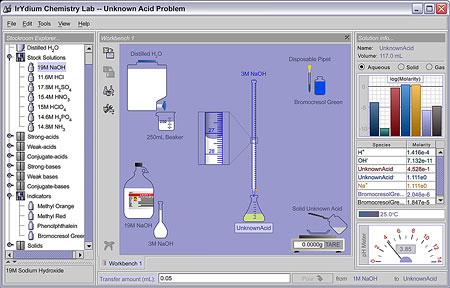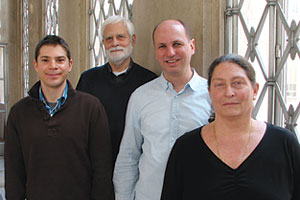
The ChemCollective Brings the Chemistry Set into the 21st Century
by Jocelyn Duffy

A java applet allows students to design and carry out their own experiments in the ChemCollective’s virtual lab space.
As any kid who has tinkered with a chemistry set can tell you, chemistry is about doing. It’s about mixing chemicals and seeing what happens. But many students across the country aren’t experiencing chemistry this way. They are learning chemistry only though textbooks, and “practicing” chemistry like it was math, balancing reactions and solving equations in a notebook.
This was a problem for David Yaron. In his opinion, scratching out the solutions to chemistry problems with a pencil and paper wasn’t enough to teach students what chemists actually do. Archaic teaching methods and limited access to laboratory space meant kids weren’t practicing chemistry, at least not like working chemists. Yaron, an associate professor of chemistry, believed that in order to get students engaged in chemistry, he needed to find a way to let students apply what they were learning in class.
“Students can learn how to do the standard written exercises that appear in textbooks without really developing an understanding of chemical concepts,” said Yaron. “For example, we found that students might be able to pass a chemistry course, but they couldn’t apply that knowledge to help them understand an article on chemistry that was written in the New York Times or Scientific American. The point of education shouldn’t be knowing enough to get an A or a B, it should be about being able to apply what you learn.”
In 1998, Yaron brought together a multidisciplinary team of software engineers, undergraduate programmers and educational consultants from Carnegie Mellon and the University of Pittsburgh to figure out a way to bring real-world experience into classrooms and students’ homes. As with many 21st century problems, they harnessed the power of computers and the Internet.
“Ready access to computers gave us the opportunity to fundamentally redesign the activities that students are asked to do in high school and college chemistry courses,” said Yaron.
The team started a project, now called the ChemCollective, that gives free access to virtual labs and other online activities that go beyond traditional textbook problems, allowing students to engage with chemistry in a way that reflects what real chemists are doing in the lab and in the field. As an added benefit, the activities can be done with just a computer, and can be used by students who don’t have access to a lab, like those in small schools and rural schools and those that are home schooled. The ChemCollective is part of the National Science Distributed Learning (NSDL) project of the National Science Foundation, which aims to make such educational resources widely accessible.
“The ChemCollective gives students the opportunity to approach chemistry more like actual scientists, by designing and carrying out their own virtual experiments and by applying chemistry concepts in real world contexts,” said Yaron.
The ChemCollective lets students complete labs assigned by their teachers or create and execute their own experiments in a virtual lab environment. They click and drag chemicals, solutions and reagents onto the lab space, measure and mix the different components in virtual beakers and flasks and get results, much as they would in an actual physical lab.
Students also can immerse themselves in scenario-based learning activities where they apply chemistry concepts to real world situations. One activity has students solving a murder mystery, another has them investigating arsenic in Bangladesh’s ground water, and yet another has them designing rocket fuel for a mission to Mars.
For the past few years, the ChemCollective’s virtual lab was downloaded more than 25,000 times and operated directly from the website more than 100,000 times per year. But this number represents only a fraction of the students and teachers actually using the program, said Yaron. Since the software is distributed freely, the group is not able to accurately determine the number of people using it.

From left: Michael Karabinos, James G. Greeno, David Yaron and Gaea Leinhardt
The program is so successful it garnered the attention of Science magazine. This year, Yaron and collaborators Michael Karabinos, Donovan Lange, James G. Greeno and Gaea Leinhardt received the magazine’s prestigious Science Prize for Online Resources in Education (SPORE). The award recognizes freely available online materials that enrich science education.
“The problem with learning chemistry from a textbook is that many of the concepts presented are abstract and difficult for students to connect to real-world experiences,” said Melissa McCartney, an editorial fellow at Science. “The ChemCollective aims to enhance chemistry education by providing online materials that allow students to use the facts and equations found in their textbooks in ways that resemble the conduct of practicing chemists, making the design and interpretation for experiments an integral part of learning chemistry.”
The site also is a resource for science instructors. Teachers who use the site are able to modify or develop their own virtual laboratory experiments and share these among a community of users. Of the 117 virtual lab activities currently available on the site, about half have been contributed by teachers. In future versions of the website, Yaron and his colleagues plan to add a forum section where teachers can discuss their labs, collaborate and provide feedback.
“Overall, The ChemCollective gives teachers and students a place to be creative with chemistry,” said Yaron. “In a way, we’re bringing the chemistry set into the 21st century.”